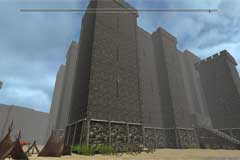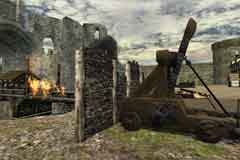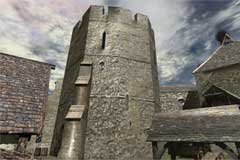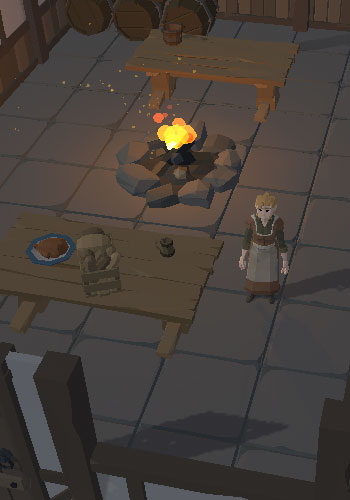Wars of the Roses
The Start of the War
 uring the late 1440's the country was being ruled poorly by King Henry VI. His wife Queen Margaret and her followers had a great influence over the weak king and in northern France many English held towns were falling to the French King Charles VII. Henry began to be openly criticised and these critisisms were being led by Richard, Duke of York. Richard himself had a good claim to the English throne being descended from Lionel of Antwerp Duke of Clarence the second son of Edward III through the female line. The Duke had the support of two strong figures of the time and both members of the Neville family. One was the Duke's brother-in-law, Richard Neville the Earl of Salisbury, and the other was the Earl's son Richard Neville Earl of Warwick.
uring the late 1440's the country was being ruled poorly by King Henry VI. His wife Queen Margaret and her followers had a great influence over the weak king and in northern France many English held towns were falling to the French King Charles VII. Henry began to be openly criticised and these critisisms were being led by Richard, Duke of York. Richard himself had a good claim to the English throne being descended from Lionel of Antwerp Duke of Clarence the second son of Edward III through the female line. The Duke had the support of two strong figures of the time and both members of the Neville family. One was the Duke's brother-in-law, Richard Neville the Earl of Salisbury, and the other was the Earl's son Richard Neville Earl of Warwick.

The First Battle of St. Albans (22 May 1455)

 he first battle of the Wars of the Roses took place at St. Alban's on May 22nd 1455 when the Yorkists tried to confront the King. The King had by his side the Dukes of Somerset and Buckingham, Lords Pembroke, Northumberland and Devon and around 2,000 Lancastrian men. They tried to hold the town against the Yorkists led by the Earls of Salisbury and Warwick but Warwick was able to enter the town through an unguarded spot and attack the flanks of the Lancastrian barricades. Although this battle was small it left the Duke of Somerset dead along with Lord Northumberland and Clifford. As a result of this victory power swung to the Yorkists although support from the Barons was not total. Richard, Duke of York, became Protector of the Realm and the powerful position of Captain of Calais was given to the Earl of Warwick.
he first battle of the Wars of the Roses took place at St. Alban's on May 22nd 1455 when the Yorkists tried to confront the King. The King had by his side the Dukes of Somerset and Buckingham, Lords Pembroke, Northumberland and Devon and around 2,000 Lancastrian men. They tried to hold the town against the Yorkists led by the Earls of Salisbury and Warwick but Warwick was able to enter the town through an unguarded spot and attack the flanks of the Lancastrian barricades. Although this battle was small it left the Duke of Somerset dead along with Lord Northumberland and Clifford. As a result of this victory power swung to the Yorkists although support from the Barons was not total. Richard, Duke of York, became Protector of the Realm and the powerful position of Captain of Calais was given to the Earl of Warwick.
Casualties of phase one
Thomas Clifford
Click shield to edit
Thomas Clifford, 8th Baron de Clifford was killed during the first battle of St. Albans on 22 May 1455. He was a Lancastrian supporter.
Henry Percy
Click shield to edit
Henry Percy, 2nd Earl of Northumberland was a Lancastrian supporter and was killed at the First Battle of St. Albans.
This is the Percy family shield.
Edmund Beaufort, 2nd Duke of Somerset
Click shield to edit
Edmund Beaufort was a Lancastrian supporter. Beaufort's early military career was a great success, but failing to prevent the loss of Anjou, Maine and Normandy to the French his career ended badly. Back in England Beaufort's popularity was low and it was only the support of the King that kept him safe. When King Henry had to relinquish power because of his mental health Edmund Beaufort was locked in the Tower of London. When the King regained power Beaufort was released from the Tower. He supported the King until being killed at the Battle of St. Albans on 22 May, 1455.
Battles of the War of the Roses

1447
1449
1450
1451
1452
1453
1454
1455
1456
1458
Event Participants and Locations
- Beaufort, Edmund (2nd Duke of Somerset)
- Richard (Duke of York)
- Henry (VI, King of England 1422-1461, 1470-1471)
- Neville, Richard (Earl of Warwick, 'The Kingmaker')
- Pole, William de la (Duke of Suffolk)
- Cade, Jack
- Margaret (of Anjou)
- Edward (of Lancaster, Prince of Wales)
- Edward (IV, Earl of March and King of England 1461-1470, 1471-1483)
- Neville, Richard (Earl of Salisbury)
- Stafford, Humphrey (Duke of Buckingham)
- Beaufort, Henry (3rd Duke of Somerset)
- Warwick Castle
- Chateau de Caen
- Tower of London
- St. Albans (May 22 1455)
- Parliament
- London
- Calais
Selection of references used:
- 1: J R Lander, The Wars of the Roses, ISBN:0-75090-018-0
- 2: Hubert Cole, The Wars of the Roses, 1973, ISBN:0-246-10618-2, Own copy
- 3: R.L.Storey, The End of the House of Lancaster, 1966, Barrie and Rockliff (Barrie Books Ltd) (1966)
- 4: Anthony Goodman, The Wars of the Roses, ISBN:0-88029-484-1
- 5: Paul Murray Kendall, Richard The Third, ISBN:ISBN-0-04-942048-8
- 6: C. W. Oman, Warwick
Medieval Episodes
Early Middle Ages
High Middle Ages
- Edward the Confessor and Godwine
- Reasons for the Norman Invasion
- The Norman Invasion
- The Norman Conquest
- Background to the Crusades
- People's and First Crusade
- Second Crusade
- Third Crusade
- Stephen's succession to the throne
- Civil War (The Anarchy)
- The Conquest of Ireland
- Henry II and Thomas Becket
- Excommunication of King John
- The First Barons' War
- The Second Barons' War
- Edward I and Wales
- Edward I and Scotland
Last Middle Ages
- Edward II and Piers Gaveston
- Robert the Bruce
- Isabella, She-Wolf of France and death of Edward II
- Edward III starts the Hundred Years War
- Continues with Richard II
- Henry V invades France
- Henry VI and Joan of Arc
- The Black Death
- The Peasants Revolt
- The Lords Appellant
- Glendower's Revolt
- Wars of the Roses
Early Modern Period
Event Participants and Locations
- Beaufort, Edmund (2nd Duke of Somerset)
- Richard (Duke of York)
- Henry (VI, King of England 1422-1461, 1470-1471)
- Neville, Richard (Earl of Warwick, 'The Kingmaker')
- Pole, William de la (Duke of Suffolk)
- Cade, Jack
- Margaret (of Anjou)
- Edward (of Lancaster, Prince of Wales)
- Edward (IV, Earl of March and King of England 1461-1470, 1471-1483)
- Neville, Richard (Earl of Salisbury)
- Stafford, Humphrey (Duke of Buckingham)
- Beaufort, Henry (3rd Duke of Somerset)
- Warwick Castle
- Chateau de Caen
- Tower of London
- St. Albans (May 22 1455)
- Parliament
- London
- Calais











